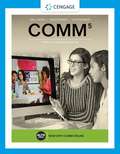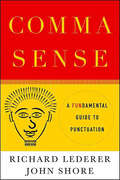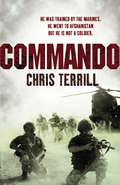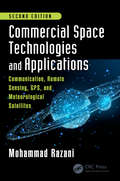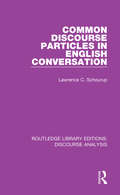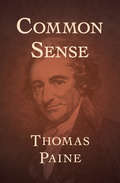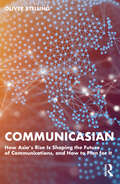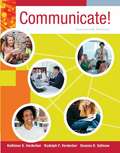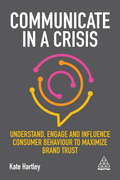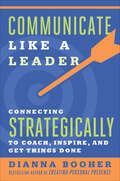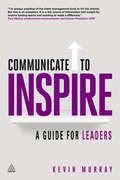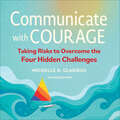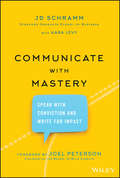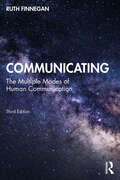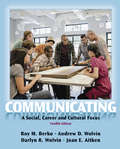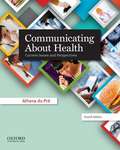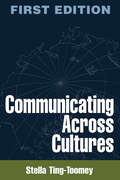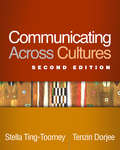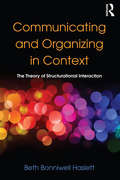- Table View
- List View
Comm 5
by Rudolph F. Verderber Kathleen S. Verderber Deanna D. SellnowLearn Communication YOUR Way with COMM5! This easy-reference, paperback textbook presents course content through visually engaging chapters and Chapter Review Cards that consolidate the best review material into a ready-made study tool. With the textbook or on its own, COMM5 Online allows easy exploration of COMM5 anywhere, anytime--including on your device. Collect your notes, browse interactive content and create StudyBits as you go, to remember what's important. Then, either use preset study resources or personalize the product through easy-to-use tags and filters to prioritize your study time. Make and review flashcards, review related content and track your progress with Concept Tracker--all in one place and at an affordable price!
Comma Sense: A Fun-damental Guide to Punctuation
by Richard Lederer John Shore“A clear, entertaining, and just plain helpful guide to the American rules of punctuation.” —Lynne Truss, #1 New York Times–bestselling author of Eats, Shoots & LeavesAre you confounded by commas, addled by apostrophes, or queasy about quotation marks? Do you believe a bracket is just a support for a wall shelf, a dash is something you make for the bathroom, and a colon and semicolon are large and small intestines? If so, language humorists Richard Lederer and John Shore (with the sprightly aid of illustrator Jim McLean), have written the perfect book to help make your written words perfectly precise and punctuationally profound.With buoyant wit and erudition, Comma Sense reveals the power and importance of each mark of punctuation. Lederer and Shore demonstrate what each has in common with a great American icon: the underrated yet powerful period with Seabiscuit; the jazzy semicolon with Duke Ellington; even the rebel apostrophe with famed outlaw Jesse James. When you’ve finished Comma Sense, you’ll not only have mastered everything you need to know about punctuation, you’ll have had fun doing so.
Commando
by Chris TerrillChris Terrill is a man in search of his limit. He's 55 years old. He is not a soldier. He is being trained by the Royal Marines and he is going to Afghanistan. The only difference is that instead of a gun, Chris will be holding a camera and filming the whole ordeal for a major TV series.The Royal Marines Commando training base in Lympstone Devon, has a famous motto: '99.9% need not apply'. Of those who start training, after a very tough selection process, nearly 50% fail to make it through the most gruelling physical tests of any armed forces in the world in an eight month training regime. The elite who do eventually pass out are generally eighteen years old and at the peak of physical condition. But Chris Terrill is the exception: this book will tell of his heroic struggle to become the oldest man to win the coveted Royal Marines Commando Green Beret and enter the record books.And after six months of hell, what next? Chris will follow the raw recruits on a tour to Southern Afghanistan. He will tell the story in book and film of the fears and hopes of the youngsters as they are plunged into one of the planet's most dangerous wars in the outlaw mountain terrain of Helmand Province. He will tell of ferocious battles against the Taliban, of firefights, of jaw-dropping heroism, British sang froid and humour and tragedy as causalities are suffered -- all from the unique perspective of a civilian who has achieved the ultimate accolade: to be accepted as an honorary Royal Marines Commando. Commando is a brilliant account of modern war on the front line.
Comment bâtir un empire d’écriture en 30 jours ou moins
by Sam Kerns Laura DinrathsVous voulez vraiment gagner votre vie en tant qu’écrivain ? Alors vous allez devoir oublier tout ce que vous savez ! Laissez-moi deviner – vous êtes un auteur talentueux et prêt à tout faire pour gagner votre pain en écrivant. Vous avez lu d’innombrables articles et livres sur le sujet, suivi leurs suggestions, mais ne semblez pas parvenir à augmenter vos revenus. Ou alors vous êtes un écrivain débutant convaincu que quelque chose vous échappe car votre propre expérience ne correspond pas du tout à ce que d’autres affirment possible. Ou peut-être que ça fait des années que vous travaillez comme écrivain freelance amateur, et vous êtes convaincu qu’il est tout simplement impossible de quitter votre ‘vrai’ boulot pour faire ce que vous aimez à plein-temps. Laissez-moi vous confier un secret. On vous a menti. Oui, vous m’avez bien entendu. MENTI. La vérité, c’est que seuls 10 pourcents des écrivains gagnent suffisamment en écrivant à temps plein pour subvenir à leurs besoins. Dix pourcents. Ce n’est pas quelque chose que les autres livres sur ‘comment écrire’ abordent en détail, si ? Heureusement, il existe une solution. Je le sais parce que ça fait des années que je la pratique. Mais afin de réussir dans ce métier, vous allez devoir renverser votre modèle de l’écrivain freelance. En fait, vous allez devoir jeter presque tout ce que vous savez par la fenêtre. Je veux parler d’un nouveau système. D’un système qui ne limite pas la capacité à gagner sa vie d’un écrivain à des contraintes de temps. Je veux parler de gagner des revenus dont tout le monde serait fier. Dans mon nouveau livre, je vais vous montrer comment créer votre propre empire d’écriture en 30 jours ou moins. Vous apprendrez : •Pourquoi la plupart des freelances ne gagnent pas bien leur vie – et que faire pour changer ça •Com
Comment écrire un Blog, Comment gagner sa vie en Bloguant
by Richard G Lowe Jr Laura DinrathsC’est un art d’écrire un article qui encourage le lecteur à prendre la décision d’agir. Voici la vision étroite du livre que vous lisez en ce moment sur votre Kindle. Vous apprendrez à créer un article qui intéresse le lecteur, l’interpelle, l’informe, et l’entraîne à prendre une décision à la fin de sa lecture. Le livre que vous lisez pour le moment décrit la méthode que j’utilise pour créer des articles de blogs dont l’intention spécifique est de pousser le lecteur du moment où il clique sur le lien jusqu’à ce qu’il clique sur le bouton ‘acheter’ ou ‘souscrire’ au bas de la page. Vous apprendez : * Comment créer un titre qui attire des lecteurs vers votre article * Quoi inclure au-dessus de la ligne de flottaison * Comment ajouter des déclencheurs émotionnels * Comment pousser vos lecteurs à partager votre article * Quelles autres informations inclure dans le texte * Comment les pousser à cliquer sur ‘acheter’ * L’importance des bonnes images * L’intérêt des vidéos
Comment Ecrire un Livre Electronique en un Mois: Étapes et astuces pour rester concentré, pour se motiver et être créatif
by Beautrice NorfolkVous cherchez à écrire un livre sans effort et en peu de temps? Apprenez les stratégies et les astuces que les auteurs professionnels à succès utilisent pour écrire des chefs-d'œuvre littéraires! À l'intérieur, vous apprendrez: - Écrivez un livre rapidement en un mois ou moins! - Démarrage. - Préparer la scène. - Créer un contour. - La génération d'idées. - Rédaction et mise au point.
Comment écrire un roman: Surmonter le blocage
by Sophie Martin Clara TiscarVous avez envie d’écrire ? Vous avez déjà eu l’impression d’être bloqué ? Vivez-vous l’angoisse de la page blanche ? Ce livre est fait pour vous si vous vous reconnaissez dans l’une des situations suivantes : ✓ J’ai envie d’écrire, mais je ne trouve pas le moment de le faire. ✓ Je suis bloqué, je ne sais pas comment continuer mon roman. ✓ Je sais quelle histoire je souhaite raconter, mais je n’arrive pas à l’écrire. ✓ Je ne suis pas vraiment bloqué, mais je manque de motivation pour continuer d’écrire mon roman. Conçu comme un guide de référence pratique et interactif, cet ouvrage vous offre méthodes et ressources pour surmonter l'angoisse de la page blanche et éviter le blocage de l'écrivain.
Commercial Space Technologies and Applications: Communication Remote Sensing Gps And Metrological Satellites Second Edition
by Mohammad RazaniThis new edition introduces and examines the space technologies that benefit our everyday lives. Each chapter now includes exercises and problems, and the content covers new satellites and emerging technologies. It explores the ever-improving quality of satellite systems and services, and also investigates ways to bring about higher resolution satellite imagery and lower satellite costs. The focus is on man-made satellites, which are becoming smaller, smarter, cheaper, and easier to launch, having a longer life span, and are less susceptible to interference. Furthermore, the book considers advances in several key technologies that affect the satellite industry. Includes extensive study questions and exercises after each chapter. Explains present commercial space technology and its future outlook. Explores the many applications of space technologies and their impact on our lives, including real world examples. Presents a future outlook on robotics, communications and navigation, and human health and nanotechnology. Provides a clear understanding of space, space technologies, space applications, space security, space regulations, a space roadmap, and their impact on the lives of humans now and for generations to come.
Common Discourse Particles in English Conversation (RLE: Discourse Analysis)
by Lawrence C. SchourupFirst published in 1985, this book studies several common items in English conversation known variously as ‘discourse particles’, ‘interjections’, ‘discourse markers’, and, more informally, ‘hesitations’ or ‘fillers’. While the analysis primarily focuses on ‘like’, ‘well’ and ‘you know’, the larger concern is the entire set of items of which these are members and as such ‘I mean’, ‘now’, ‘oh’, ‘hey’, and ‘aha’ are also examined. These discourse particles are analysed at length and then a framework is proposed in which their use individually makes sense and allows revealing comparisons to be made between them. This book will be of interest to students of linguistics
Common Sense
by Thomas PaineThe rousing argument for independence that inspired a nation Published anonymously in 1776, this landmark political pamphlet spread across the colonies more rapidly than any document of its kind ever had before. Its words were read aloud in town squares, its pages affixed to tavern walls. Both a clear-eyed, plainly stated case for separation from Great Britain and a stirring call to action, Common Sense sparked the imagination of a fledgling nation and played a decisive role in the march toward revolution. Thomas Paine’s masterpiece is crucial reading for any student of American history. This ebook has been professionally proofread to ensure accuracy and readability on all devices.
Commonplaces of Scientific Evidence in Environmental Discourses (Routledge Studies in Technical Communication, Rhetoric, and Culture)
by Denise TilleryThis book focuses on the uses of scientific evidence within three types of environmental discourses: popular nonfiction books about the environment; traditional and social media texts created by a grassroots environmental group; and a set of data displays that make arguments about global warming in a variety of media and contexts. It traces the operations of eight commonplaces about science and shows how they recur throughout these contexts, starting with Rachel Carson’s Silent Spring and ending with contemporary blogs and social media. The commonplaces are shown to embed ideological assumptions and simultaneously challenge those assumptions. In addition, the book addresses the potential dangers involved in relying too heavily on aspects of these commonplaces, and how they can undermine the goals of some of the writers who use them.
CommunicAsian: How Asia's Rise Is Shaping the Future of Communications, and How to Plan for It
by Oliver StellingThe rise of Asia has changed the world, now shaped by greater global connectivity, geopolitics and shifting spheres of influence. Tapping into research and decades of experience in the world’s fastest-moving markets, this book makes a compelling case for a new and future-ready approach to communications planning and implementation, which the Asian Century demands. Facing a new operating environment, policymakers and business leaders have to act quickly. This book outlines the necessary adjustments to long-established practices and value propositions in both corporate and government communications and provides a step-by-step plan for strategy development, laid out in a two-pronged approach designed to appeal to a multicultural audience. It is an essential read for global practitioners and students in international relations and mass communications.
Communicate! (Fourteenth Edition)
by Kathleen S. Verderber Rudolph F. Verderber Deanna D. SellnowNow in its 14th edition, this ground-breaking, market-leading fundamentals of human communication text helps readers improve their communication competency by becoming proficient in using theory and research-grounded communication skills. Praised for its clear and concise writing style, this new edition includes increased coverage of how technology and social media are changing communication practices and offers guidelines for best practice. Lively contemporary examples and sample speeches ground theory, increase comprehension, and help readers become skillful communicators. COMMUNICATE! engages students in active learning through theory, application and skill-building exercises including speech action step activities that guide students through the speech preparation process. The role of ethics in communication is integrated throughout the text, and students can also apply ethical principles to case situations.
Communicate in a Crisis: Understand, Engage and Influence Consumer Behaviour to Maximize Brand Trust
by Kate HartleyCommunicate in a Crisis is the definitive guide for any PR or marketing professional to recognize, plan and respond to a sudden wildfire of consumer-led reaction, 'manipulated outrage' sparked from interaction on news feed algorithms, fuelled by social media and the constant demand for an instantaneous response.This book turns the traditional crisis management approach on its head, starting by understanding changing consumer behaviours and the new 'threat' for brands, then outlining practical steps to prepare, synchronize and execute a coordinated brand response across all channels - under pressure. It reveals why we love to hate our favourite brands, how to recognize a day to day problem from a crisis, and offers valuable advice, such as using influencers and brand advocates to address social media trolls, rumours and the impact of fake news. With unique case studies, interviews and anecdotes from global leaders, Communicate in a Crisis will embed a bottom-up culture of long-term reputation management, always ready to face the unexpected.
Communicate Like a Leader: Connecting Strategically to Coach, Inspire, and Get Things Done
by Dianna Booher John Britt Ed Jent&“Great leaders are great communicators…If you want to become a top-notch strategic communicator, you&’d do well to heed the advice in [this book&’s] pages.&” —Marshall Goldsmith, New York Times-bestselling author of What Got You Here Won&’t Get You ThereAn Axiom Awards Silver Medal Winner People often get promoted to leadership positions without knowing how to communicate an inspiring strategic vision to the people who report to them. So they focus on what they know: tactics, not strategy. As a result, they become stuck in micromanagement mode—driving people away instead of drawing them in. Dianna Booher wants to prevent micromanagement before it happens by providing you with the right leadership communication skills. Grounded in extensive research, this book offers practical guidelines to help professionals think, coach, converse, speak, write, meet, and negotiate strategically to deliver results. In thirty-six brief chapters, Booher shows you how to communicate effectively to audiences up and down the organization so you can fulfill your most essential responsibilities as a leader. &“If you&’re a micromanager, you need to know it&’s not just ineffective—it&’s also the most labor-intensive leadership style. When you read Communicate like a Leader, you&’ll learn strategic communication skills that will improve your relationship with your people and actually make leading easier.&” —Ken Blanchard, New York Times-bestselling coauthor of The New One Minute Manager
Communicate to inspire
by Kevin MurrayCommunicate to Inspire answers some of the key practical questions for becoming a better leader, such as: "How do you learn to be yourself, better?" and "What should you examine and how should you articulate your own purpose and values?" Kevin Murray presents a model that charts the leadership process and draws stories from his experience coaching leaders. This book offers principles of leadership communication that address: how to become more audience-centric; how to emphasize values; how to focus on the people leaders need to inspire; what methods and tools to use to try to see the world through their eyes and address their needs; and mastering the art of public speaking. Communicate to Inspire uses charts and information gathered from dozens of successful training programs to determine how to turn a department, division or company into a better listening, faster responding, more innovative entity, just by holding more and better structured conversations.
Communicate with Courage: Taking Risks to Overcome the Four Hidden Challenges
by Michelle D GladieuxConfront the psychological blocks that are holding you back—and become a fearless and peerless communicator. Winner of the 2023 PenCraft Best Book Award for Nonfiction, 2023 Nonprofit Authors Association Silver Award, 2023 Readers&’ Favorite Bronze Medal Award for Business, and 2023 Dan Poynter&’s Global Ebook Gold Award for Communications As a lifelong communication coach, Michelle Gladieux has discovered the four sneaky obstacles that can keep you from becoming an effective communicator:Hiding—Fearing your low self-confidence will expose your supposed weaknessesDefining—Putting too much stock into your assumptions and being quick to judge right and wrongRationalizing—Using &“being realistic&” to shield yourself from taking chances, engaging in conflict, or doing other scary but potentially rewarding actionsSettling—Stopping at good enough instead of pushing for something better What all these challenges have in common is they require taking risks—to reveal yourself, to question your beliefs, to take a leap of faith, or to move out of your comfort zone. As a response, each chapter includes a Pro Move, or a best practice, and an exercise designed to help you overcome your fears and become a powerful communicator. Courageous communication requires self-knowledge, practice, and a fierce desire to continually improve; this book is like having an expert coach along with you for every step of the journey. &“[A] wonderful book.&” —Karl W. Einolf, PhD, President, Indiana Institute of Technology
Communicate with Mastery: Speak With Conviction and Write for Impact
by JD SchrammDevelop your leadership communication Communicating with Mastery provides readers with a rich treasure trove of frameworks and tools for leadership communication as developed and taught over the past decade at Stanford's Graduate School of Business. Designed for the business leader on the go, it provides you quick access to helpful approaches to vexing communication problems leaders face today in speaking and writing to various audiences. Projects often fail not because of the vision, but in the articulation of that vision. With the help of this book, you’ll learn how to ensure you get the results you desire as a leader and communicator including: Speak with conviction and write with impact Tailor your communication to any goal, setting, or audience Scale your leadership through effective coaching Every time you write or speak, you need to make your words count. And this book shows you how.
Communicating: The Multiple Modes of Human Communication
by Ruth FinneganTreatments of human communication mostly draw on cognitive and word-centred models to present it as predominantly a matter of words. This, Finnegan argues, seriously underestimates the far-reaching multi-modal qualities of human interconnecting and the senses of touch, olfaction, and, above all, audition and vision that we draw on. In an authoritative and readable account, Ruth Finnegan brings together research from linguistic and sensory anthropology, material culture, non-verbal communication, computer-mediated communication, and, strikingly, research on animal communication, such as the remarkable gesture systems of great apes. She draws on her background in classical studies and her long anthropological experience to present illuminating examples from throughout the world, past and present. The result is to uncover an amazing array of sounds, sights, smells, gestures, looks, movements, touches, and material objects used by humans and other animals to interconnect both nearby and across space and time She goes on to first explore the extra-sensory modes of communication now being revealed in the extraordinary "new science" research and then, in an incendiary conclusion, to deny the long-prevailing story of human history by questioning whether orality really came before literacy; whether it was really through "the acquisition of language" that our prehistoric cave painting ancestors made a sudden leap into being "true humans"; and finally, astonishingly, to ask whether human communicating had its first roots not, after all, in verbal language but something else. Not to be missed, this highly original book brings a fresh perspective on, among other things, that central topic of interest today – the dawn of human history – and on what being homo sapiens really means. This revised and updated edition has additional illustrations, updated chapters, and a new concluding chapter. A provocative and controversial account that will stir worldwide debate, this book is an essential transdisciplinary overview for researchers and advanced students in language and communication, anthropology, and cultural studies.
Communicating: A Social, Career, and Cultural Focus (Mycommunicationlab Ser.)
by Andrew Wolvin Darlyn R. Wolvin Roy Berko Joan E. AitkenThis highly-regarded introduction to communication book offers a comprehensive blend of basic communication theory, research, and skills, with a strong emphasis on relationship communication (social), workplace (career), and intercultural communication (culture). Communicating introduces the basic principles of communication and applies them to interpersonal, group, interviewing, and public speaking contexts. The book stresses communication competence through boxed material, Learn by Doing activities, thought-provoking questions, and self-assessment tests. New and strengthened pedagogy highlights and reinforces the book's social, career, and cultural themes, with a particular emphasis on intercultural communication and communicating in an increasingly high-tech, global environment.
Communicating About Health: Current Issues And Perspectives, 4th Edition
by Athena DupréAn ideal combination of communication theory and practical advice, Communicating About Health: Current Issues and Perspectives, Fourth Edition, is an indispensable resource for readers looking to improve their communication abilities in the health care field. Written by Athena du Pre - anexperienced researcher and noted scholar - the text offers an excellent balance of theory and practice; research and pedagogy; coverage of patient/caregiver issues; and material on the current, historical, and philosophical backgrounds of communication in health care. In addition to enhancingfeatures found in the previous edition, this new edition includes a greater emphasis on theory, narrative, and technology in order to reflect changes in the health industry.
Communicating Across Cultures
by Stella Ting-ToomeyFrom high-level business negotiations to casual conversations among friends, every interpersonal interaction is shaped by cultural norms and expectations. Seldom is this more clearly brought to light than in encounters between people from different cultural backgrounds, when dissimilar communication practices may lead to frustration and misunderstanding. This thought-provoking text presents a new framework for understanding the impact of culture on communication and for helping students build intercultural communication competence. With illustrative examples from around the globe, the book shows that verbal and nonverbal communication involves much more than transmitting a particular message it also reflects each participant's self-image, group identifications and values, and privacy and relational needs. Readers learn to move effectively and appropriately through a wide range of transcultural situations by combining culture-specific knowledge with mindful listening and communication skills. Throughout, helpful tables and charts and easy-to-follow guidelines for putting concepts into practice enhance the book's utility for students.
Communicating Across Cultures, Second Edition: Esl Learners In The Non-esl Classroom (The\guilford Communication Ser.)
by Stella Ting-Toomey Tenzin DorjeeThis highly regarded text--now revised and expanded with 50% new material--helps students and professionals mindfully build their knowledge and competencies for effective intercultural communication in any setting. The authors' comprehensive, updated theoretical framework (integrative identity negotiation theory) reveals how both verbal and nonverbal communication are affected by multilayered facets of identity. Written in a candid, conversational style, the book is rich with engaging examples illustrating cultural conflicts and misunderstandings that arise in workplace, educational, interpersonal, and community contexts. Readers learn how to transform polarized conversations into successful intercultural engagements by combining knowledge about culture with mindful listening and communication skills. New to This Edition *Extensively revised to reflect the ongoing development of integrative identity negotiation theory, nearly 20 years of research advances, the growing diversity of the United States, and global trends. *Chapter providing a mindfulness lens on intercultural and intergroup communication competence. *Chapter on culture shock in sojourners (international students, global businesspeople, and others). *Chapter on immigrants' acculturation processes. *Lively chapter-opening case examples, including compelling personal stories from the authors and others from diverse cultures. *End-of-chapter summaries, "Mindful Guidelines" to put into practice, and critical thinking questions. *New and expanded discussions of hot topics: cross-cultural workplaces, community building, peace building, romantic relationships, prejudice and discrimination, microaggressions, and ethical issues.
Communicating Affection
by Kory FloydExplores how and why people express affection, the many positive effects it can have, and the risks it often carries.
Communicating and Organizing in Context: The Theory of Structurational Interaction (Routledge Communication Series)
by Beth Bonniwell HaslettCommunicating and Organizing in Context integrates Giddens’ structuration theory with Goffman’s interaction order and develops a new theoretical base—the theory of structurational interaction—for the analysis of communicating and organizing. Both theorists emphasize tacit knowledge, social routines, context, social practices, materiality, frames, agency, and view communication as constitutive of social life and of organizing. Thus their integration in structurational interaction provides a coherent, communication-centric approach to analyzing communicating, organizing and their interrelationships. This book will be a valuable resource for students and scholars as an orientation to the field of organizational communication and as an integration of organizing and communicating. It will also be useful for practitioners as a tool for understanding how conceptual frames limit possibilities and constitute the nature of organizing and members' participation in organizations.
